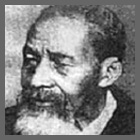Jump to:
- Fountain Hughes
- George Johnson
- Uncle Bob Ledbetter
- Uncle Billy McCrea
- Isom Moseley
- Wallace Quarterman
- Charlie Smith
Approximately four million Americans enslaved in the United States were freed at the conclusion of the American Civil War. The stories of a few thousand have been passed on to future generations through word of mouth, diaries, letters, records, or written transcripts of interviews. Only twenty-six audio-recorded interviews of ex-slaves have been found. This collection captures the stories of former slaves in their own words and voices. Little biographical information about them is available. Apart from their voices, photographs have been found only for the seven individuals below. Look at their faces as you listen to them talk about their lives, describing what it was like being a slave and becoming free.
Fountain Hughes, Age 101
"You wasn't no more than a dog to some of them in them days. You wasn't treated as good as they treat dogs now. But still I didn't like to talk about it. Because it makes, makes people feel bad you know. Uh, I, I could say a whole lot I don't like to say. And I won't say a whole lot more."
Read or listen to the rest of the narrative...

Fountain Hughes, circa 1952. Photograph courtesy of The Jeffersonian newspaper, Towson, Maryland.
George Johnson, Age Unknown
"I got my name from President Jeff Davis. He was president of the Southern Confederacy. He owned my grandfather and my father. Brought them from Richmond, Virginia."
Read or
listen to the rest of the narrative...

George Johnson, circa 1935. Library of Congress Manuscripts Division - Montgomery Family Papers. Photomechanical print.
Uncle Bob Ledbetter, Age 72 or 73
"Yes sir, I know what's right and I tried my best to do what's right in everything I do."
Read or
listen to the rest of the narrative...

![]()
![]() Uncle Bob Ledbetter, October, 1940. Library of Congress Prints & Photographs Division - Lomax Collection. Photograph. Call Number: LOT 7414-B, no. N71.
Uncle Bob Ledbetter, October, 1940. Library of Congress Prints & Photographs Division - Lomax Collection. Photograph. Call Number: LOT 7414-B, no. N71.
Isom Moseley, Age 88
"Well now, they tell me it was a, a year before the folks knowed that, uh, they was free. And when they found out they was free, they worked on shares, they tell me. Worked on shares, didn't rent no land, they worked on shares. Now you know I was a boy, I'm about explaining to the best of my understanding. They say they worked on shares. I think they said it was, was it fourth, or third I think. They got the third, I think they say, what they made,??? after surrender."
Read or
listen to the rest of the narrative...

![]()
![]() Isom Moseley, October, 1939. Library of Congress Prints & Photographs Division - Farm Security Administration - Office of War Information Photograph Collection. Photograph by Marion Post Walcott. Call Number: LC-USF33- 030363-M5.
Isom Moseley, October, 1939. Library of Congress Prints & Photographs Division - Farm Security Administration - Office of War Information Photograph Collection. Photograph by Marion Post Walcott. Call Number: LC-USF33- 030363-M5.
Uncle Billy McCrea, Age 89
"And I remember and the Yankees stop here, and the Yankees stop right here on the courthouse square. I was a good size boy then. And then what they call Freedman Bureau, you hear tell of it ain't you? And they prosecuting people you know, what they do, you know, and all like that, and I mean just as hard as they could. I've seen two mens they had they were punishing for what they do."
Read or
listen to the rest of the narrative...

![]()
![]() Billy McCrea, October, 1940. Library of Congress Prints & Photographs Division - Lomax Collection. Photograph by Ruby T. Lomax. Call Number: LOT 7414-F, no. N39.
Billy McCrea, October, 1940. Library of Congress Prints & Photographs Division - Lomax Collection. Photograph by Ruby T. Lomax. Call Number: LOT 7414-F, no. N39.
Wallace Quarterman, Age 87
"And he call me and told me to run down in the field and tell Peter to turn the people loose, that the Yankee coming. And so I run down in the field and, and whooped and holler, they done, he done told them Mr. [Gaeggles (?)] said turn the people loose because the Yankee coming."
Read or
listen to the rest of the narrative...

![]()
![]() Wallace Quarterman, 1935. Library of Congress Prints & Photographs Division - Lomax Collection. Photograph by Alan Lomax. Call Number: LOT 7414-C, no. N87.
Wallace Quarterman, 1935. Library of Congress Prints & Photographs Division - Lomax Collection. Photograph by Alan Lomax. Call Number: LOT 7414-C, no. N87.
Charlie Smith, Age Uncertain
"The highest bidder gets you. He'll carry [you to (?)] his plantation. Put another one up there. Me highest bid, which ever one bid, gives the most, he'll carry him to his plant, that the white, in the South. And they went to mistreating the, the colored. Getting children by the colored women. And all such as that, getting colored. And the white find it out, how they was treating them. They hurt them. And they come down here, the first war ever was in the United State was the North and South fought a war to free the colored."
Read or
listen to the rest of the narrative...

Charlie Smith, 1976. Photograph by Peggy Kehoe, courtesy of The Polk County Democrat, Bartow, Florida.